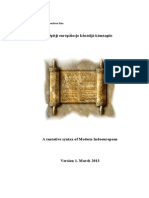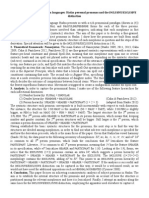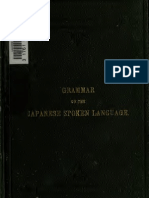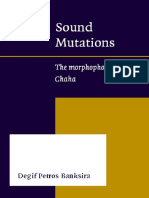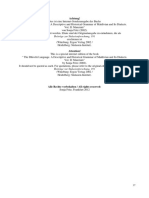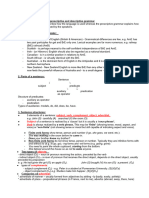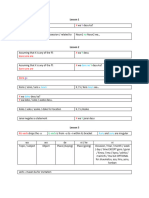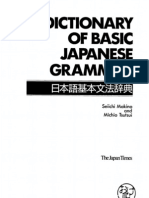0 ratings0% found this document useful (0 votes)
74 views295 pagesA Dictionary of Basic Japanese Sentence Patterns
Japanese Patterns
Uploaded by
kama.dev.jiCopyright
© © All Rights Reserved
We take content rights seriously. If you suspect this is your content, claim it here.
Available Formats
Download as PDF or read online on Scribd
0 ratings0% found this document useful (0 votes)
74 views295 pagesA Dictionary of Basic Japanese Sentence Patterns
Japanese Patterns
Uploaded by
kama.dev.jiCopyright
© © All Rights Reserved
We take content rights seriously. If you suspect this is your content, claim it here.
Available Formats
Download as PDF or read online on Scribd
You are on page 1/ 295
A Dictionary of
Basic
Japanese
Sentence
Patterns
Naoko Chino
Distributed in the United States by Kodansha America, Inc., 575
Lexington Avenue, New York N.Y. 10022, and in the United
Kingdom and continental Europe by Kodansha Europe Ltd., 95
Aldwych, London WC2B 4JF. Published by Kodansha Interna-
tional Ltd., 17-14 Otowa I-chome, Bunkyo-ku, Tokyo 112-8652,
and Kodansha America, Ine.
Copyright © 2000 by Kodansha International Ltd.
All rights reserved. Printed in Japan
First edition, 2000
00 0102 03 1098765432
ISBN 4-7700-2608-0
CONTENTS
Preface 18
EAE 24
Abbreviations and Definitions 27
Laude
ie Noun and Adjective Sentences 29
cuapter 1 Basic Patterns 1-3 30
® Basic Pattern 1 ~ 3 @ Variation 2 sense nseeeees AO
Noun Sentence Adjective Sentence with mo
NLIEN2 CHS after the Subject
NI wa N2 desu. N® Adj CF.
N1is N2. Nimo Adj desu.
Nalso is Adj.
& Basic Pattern 2 32
Adjective Sentence ® Variation 3 42
NILAdj CF. Noun Sentence in Past Tense
N wa Adj desu. NIIEN2 TL.
Nis Adj. NI wa N2 deshita,
. NI was N2.
Basic Pattern 3 36
Adjective Modifying @ Variation 4 43
the Subject L-adjective and Na-adjective
1, Ladjl NI td N2/I-adj2 CT.
Ladjl NI wa N2/I-adj2 desu.
Adj NisN/Adj.
2.Na-adji NI (LN2/Na-adj2 CF >
Na-adjl NI wa N2 / Na-adj2
desu.
Adj NisN/ Adj.
® Variation 1 39
Noun Sentence with mo after the
Subject
NIBN2TH.
NI mo N2 desu.
Nl also is N2.
Sentences in Past Tense
LNikLadj Poke TH.
N wa 1-adj (past tense) desu.
Niwas Adj.
2.N IE Na-adj C Lito
Nwa Na-adj deshita,
Nwas Adj.
Variation 5 46
Noun and Adjective Sentences
as Questions
LNIIEN2 THA
NI wa N2 desu ka.
IsNEN2?
ZNIk badj CHA%
Nowa I-adj desu ka.
IsN Adj?
3. NIXNa-adj THA
Nwa Na-adj desu ka.
IsN Adj?
# Variation 6 60
Questions with Interrogative
Words
Nd Interrog CFA.
Nwa Interrog desu ka.
Interrog is N?
# Variation 7 52
N2 desu ka, N3 desu ka as
Predicate in Questions
LNUEN2 THA NZ THA
NI wa N2 desu ka, N3 desu ka.
Is N1 N2 or N3?
N wa Adjl desu ka, Adj2 dest ka.
Is N Adjl or Adj2?
@ Variation 8 55,
Negative Noun and Adjective
Sentences
LNIIEN2 THSY HAAS
Cth) EEATLED
NI wa N2 dewa arimasen/
dewa arimasen deshita.
N1is/ was not N2.
Nid Ladj C40 / KE PoP
ch.
Nwa F-adj-ku nai /-ku nakatta
desu.
Nis/ was not Adj.
3.N 1d Na-adj THY EAEA/
THHDETATLZD
N wa Na-adj dewa arimasen /
dewa arimasen deshita.
DNISAGU THA Adj2 THA Nis / was not Adj.
cuarrer 2 Basic Patterns 4-5 _ _ 60
m Basic Pattern 4 « 60 NI no N2 wa N3 desu.
Noun Sentences with N2 no NI’s N2 is N3.
N3as Predicate 2.NLO N2 1b Adj THs
NIIEN2ZON3 CH NI no N2 wa Adj desu.
NI wa N2 no N3 desu. NI’s N2is Adj.
NI is N2’s N3.
Basic Pattern 5 68
@ Variation 1 64 Noun Sentence with N2 to N3
Noun Sentence with N2 no as as Predicate
Predicate NIIEN2E NSCS
NIENZOTH
Niwa N2 no desu.
Nl is N2’s.
@ Variation 2 “66
Noun and Adjective Sentences
with NI no N2as Subject
L.NIDN2EN3 TH.
NI wa N2 to N3 desu.
N1 is N2 and N3.
Variation 1 70
Noun and Adjective Sentence
with NI fo N2as Subject
LN E N2UEN3B TH.
NI to N2 wa N3 desu.
Ni and N2 are N3.
2NLE NZIS Adj CHS
NI to N2 wa Adj desu.
NI and N2 are Adj.
8 Variation 2 73
‘Two Noun Sentences Connected
by de
NIIEN2°C. N3IENATHO.
NI wa N2 de, N3 wa N4 desu,
N1 is N2, and N3 is N4.
Variation 3 75
Adjective Sentence with AdjI
te/de Adj2as Predicate
NI& Adjl T/T Adj2 CF.
Nwa Adjl -te/de Adj2 desu.
Nis Adjl and Adj2.
® Variation 4 7
Adjective Sentence with Adjec-
tives Connected by shi/da shi
Nid Adjl L/7EL, Adj2 THe
Nwa Adjl shi/da shi, Adj2 desu.
Nis Adjl and also Adj2.
cuapter 3 Basic Patterns 6-14 80
®@ Basic Pattern 6 80 ™ Basic Pattern 9 85
Adjective Sentence with Topic Adjective Sentences Connected
(wa) and Subject (ga) by te/de
NI lk N26 Adj CF. Ni Ud Adjl TC /°G (N2 Id) Adj2
NI wa N2 ga Adj desu. Ch.
Concerning N1, N2 is Adj. Nl wa Adjl -te /de (N2 wa) Adj2
m Basic Pattern 7 82 desu,
Adjective Sentences with Topic N1is Adjl, and / so N2 is Adj2.
/ Subject and shi/da shi Basic Pattern 10 38
. . asic Pattern o
NIIEN2B Adj L/EUN3D Noun Sentence with the Sub-
Adj2 TF. ject Omitted
NI wa N2 mo Adjl shi/da shi (NL 18) N2°C Ho
N3 mo Adj2 desu. (NI wa) N2 desu.
Concerning N1, N2 is Adjl, and (N1 is) N2.
NB is Adj2.
Basic Pattern 11 90
m Basic Pattern 8 8a Adjective Question with
Adjective Sentences Connected dochiraand Answer with ho
by ga/da ga LNIENZELB SAAT
NL tk N2 tk Adjl AE/ EAE NS Ta.
ik Adja THe NI to N2 to dochira ga Adj desu
. ka.
NI N2 Adjl di N3
aay i deste ga/da ga Which one is Adj, NI or N2?
Concerning N1, N2 is Adjl, but 2. NI (N2) DIE 4 A Adj CT
Nis Adj2. NI (N2) no ho ga Adj desu.
NI (N2) is Adj.
@ Variation | 92
Adjective Sentence Stating
Preference with hd and yori
NI DUEF ANZ EY adj TF.
NI nto ho ga N2 yori Adj desu.
NI is more Adj than N2.
wm Basic Pattern 12 ~ G8
Adjective Question with dore
and Answer with ichiban
LNIENZENZOUC, EN
28H Adj CTA.
NI to N2 to N3 no naka de,
dore ga ichiban Adj desu ka.
Among N1, N2, and N3, which
is the most Adj?
2. NI (N2/N3) BEB Adj TH
NI (N2/N3) ga ichiban Adj desu,
cuarrer 4 Basic Patterns 15-17
w Basic Pattern 15 100
Subjunctive Adjective Sen-
tence with tara/dattara
NIA Ad ES /Kokd
Adj2 TF o
NI wa/ ga Adjl -tara /dattara
Adj2 desu.
JEN1 is Adjl, then Adj2.
@ Variation | 102
Subjunctive Adjective Sentence
with to/da to
Nid AeA E/E adja CF.
Nwa /ga Adjl to /da to Adj2 desu.
Itis Adj2 if N is Adjl.
Variation 2 104
Subjunctive I-adjective Sen-
tence with kereba
N1 (N2/N3) is the most Adj.
96
Adjective Sentence Indicating
Equality with onaji kurai
NIE NZ EK US Be (Adj)
TH.
NI wa N2 to onaji kurai (Adj)
desu.
Nl is about the same (Adj) as N2.
m Basic Pattern 14 98
Adjective Sentence Indicating
Inequality with hodo ...
nai
NI Id N2UE E Ladj ¢ ZT
F/Naadj THY) ETA.
Nl wa N2 hodo I-adj-ku nai desu
/Na-adj dewa arimasen.
N1is not as much Adj as N2.
_—____!00
NIE/A¥ Ladj WUE Adj TH.
Nwa/ga I-adj-kereba Adj desu.
It is Adj if Nis Adj.
# Variation 3 106
Subjunctive Adjective Sentence
with nara
NI (dk / 28 Adj /N2 % % Adj2
tH.
NI wa / ga Adjl /N2 nara Adj2
desu,
It is Adj2 if NI is Adjl /N2.
m Basic Pattern 16 108
Adjective Sentence about
Appearance with -s6
NI AdGTI TH.
Nwa Adj-s6 desu.
Nlooks like Adj.
@ Variation 1 V0
Negative Adjective Sentence
about Appearance with -s6
Nid Adj eF THHY ETA.
Nwa Adj-so dewa arimasen.
N doesn’t look like Adj.
m Basic Pattern 17 12
Adjective Sentence Indicating
Hearsay with so
NIL AGSI/ETITH.
Nwa Adj s6/da so desu.
‘They say Nis Adj.
@ Variation 1 4
Negative Adjective Sentence
Indicating Hearsay with so
LN Lad) < BVSZI TH.
Nwa F-adj-ku nai so desu,
‘They say N isn’t Adj.
2NUNaadj CBS TH.
Nwa Na-adj dewa nai so desu.
‘They say N isn’t Adj.
Variation 2 "7
Conjectural Noun and Adjec-
tive Sentences with daré to
omoimasu
NUENI/AG RAF EBOET.
NI wa N2/Adj daré to omoimasu,
I think N1 is N2/ Adj.
PART
y Verb Sentences 121
cuapter | Basic Pattern 18 7 122
w Basic Pattern 18 122 w Variation 2 127
Verbs of Existence for Inani-
mate and Animate Objects
LNAV(HV EF).
Nga V (arimasu).
Nexists.
LNBV(WED).
Nga V (imasu).
Nexists.
@ Variation 1 125
Verbs of Existence with mo after
the Subject
LNSV(SYV EF).
N mo V (arimasu).
Nalso exists.
ZNEV(WED).
N mo V (imasu),
Nalso exists.
Verbs of Existence in Questions
LNAV (HY EF) Do
N ga V (arimasu) ka.
Does N exist?
ZNAV(VEF) Dr
Nga V (imasu) ka.
Does N exist?
w Variation 3 129
Verbs of Existence with Inter-
rogatives
1. Interrog 2° V (2) EF) Ar
Interrog ka V (arimasu) ka.
Does any Interrog exist?
2. Interrog 2° V (V2 EF) Ao
Interrog ka V (imasu) ka.
Does any Interrog exist?
@ Variation 4 132
Verbs of Existence in the Neg-
ative
LNA HAV(HY EAA).
N ga /wa V (arimasen).
N does not exist.
DNV (WEA).
Nga /wa V (imasen).
N does not exist.
@ Variation 5 134
Negative Verbs of Existence with
mo after the Subject
LNSV(HY EttA).
No V (arimasen).
There isn’t any N.
LNBV(VETA).
N mo V (imasen).
‘There isn’t any N.
m Variation 6 ~~ 137
Verbs of Existence in the Past
Tense
la NAIV(HYV ELK)
Nga V (arimashita).
Nexisted.
ID.NATV (OE LE)
cuaprer 2 Basic Patterns 19-22 _
m Basic Pattern 19 147
V-masu Sentence in the Present
/ Future Tense
NUVEF.
Nwa V-masu.
N does V. / N will do V.
m Variation 1 149
V-masu Sentence with mo
after the Subject
NOVEF.
N mo V-masu.
Nga V (imashita).
Nexisted.
2a NBV(HY) EA TL?)
N ga V (arimasen deshita).
N did not exist.
2b.N AV (VERA TLE).
N ga V (imasen deshita).
N did not exist.
@ Variation 7 141
Verbs of Existence with Place
(ni) and Subject
LNIIEN2DV(HV ED).
NI ni N2 ga V (arimasu).
N2isat (on, in, under etc.) NI.
ZNUCN2BV(WEF)o
NI ni N2 ga V (imasu).
N2isat (on, in, under etc.) NI.
® Variation 8» sevens PAZ,
Verbs of Existence with Sub-
ject and Place (ni)
LNUIENZEV(HY ET).
NI wa N2 ni V (arimasu).
N1isat (on, in, under etc.) N2.
ZNUIENIICV(WED)6
NI wa N2 ni V (imasu),
N1 isat (on, in, under etc.) N2.
147
Nalso does V. / N also will do V.
® Variation 2 18}
V-masu Sentence as Question
NIVETD.
Nwa V-masu ka.
Does N V?/ Will N V?
# Variation 3 182
V-masu Sentence in the Negative
Nikv EttA.
N wa V-masen.
N does not V. / N will not V.
@ Variation 4 154
V-masu Sentence in the Past
Tense
Ni&VELK.
Nwa V-mashita.
NdidV.
w Basic Pattern 20 185
Time Indicated by ni
NIIEN2ZIE VES.
NI wa N2 ni V-masu.
NI does V at N2./ NI willdo V
at N2.
w Pattern 2] eons BT
Direction of Movement Indi-
cated by ni/e
NLIENIN/IV EF.
Ni wa N2e/ni V-masu.
NI goes to N2. / NJ will go to N2.
@ Variation 1 -- . 158
Time (ni) and Movement (ni/e)
NIENDIENIN/E VES.
NI wa N2 ni N3 e/ni V-masu.
m Basic Pattern 22 ~~ 160
Direct Object Indicated by 0
NUENZEVEF.
NI wa N20 V-masu.
NI V’s/ will V N2.
a Variation 1 162
Direct Object (0) and Loca-
tion (de)
NUILN2TNIZVEF.
NI wa N2 de N30 V-masu.
NI V’s/ will VN3 at N2.
@ Variation 2 164
Time (ni), Location (de), and
Direct Object (0)
NUEN2IZNITNIEV EF.
NI wa N2 ni N3 de N40 V-masu.
N1V’s/ will V N4 at N2in N3.
Variation 3 166
Purpose of V-masu Verb Indi-
cated by ni
NUEN2F VII VI2EF.
NI wa N20 V1 ni V2-masu.
NI goes to N3 at N2. / NI will go Ni V2’s /will V2 in order to VI N2.
to N3 at N2.
cuapter 3 Basic Patterns 23-27 _ 168
m Basic Pattern 23 168 N wa V-te imasu.
Te imasu Showing Action in Nis doing / does V (on a regular
Progress basis).
NUVTOET.
Nwa V-te imasu. w Variation 2 172
NisdoingV. Te imasu Showing an Uninten-
tional State or Condition
# Variation 1 soe VIO NAVTOES.
Te imasu Showing Regular or Nwa V-te imasu.
Habitual Action Nis in the condition of V.
NAVTREF.
& Variation 3 174
Te arimasu Showing an Inten-
tional State or Condition
NAV THD ET.
Nga V-te arimasu.
Nhas been put in the state of V.
wm Basic Pattern 24 175
Te Form Indicating Successive
Actions
NUVIT. V2T. VIEF.
Nwa Vi-te, V2-te, V3-masu.
N does V1, V2, and V3.
@ Variation | V7
Te kara Indicating One Action
Occurs after Another
NILVITAPS V2EF.
Nwa V1-te kara V2-masu.
N does / will do V2 after V1.
@ Variation 2 179
Mae nilndicating One Action
Occurs before Another
Nid vite v2 EF.
Niwa VI mae ni V2-masu.
N does / will do V2 before V1.
m Basic Pattern 25 180
Te kudasai for a Polite Request
VERSO.
V-te kudasai.
Please do V.
w Variation 1 182
Nai de kudasai for a Negative
Polite Request
VEUTCRS A.
V-nai de kudasai.
Please don’t do V.
w Variation 2 184,
Te kudasaimasen ka fora
Polite Request
VEC ESWEtAD
V-te kudasaimasen ka.
Would you please do V?
= Variation 3 185
Te itadakemasen ka for a
Polite Request
VEORETERAD
V-te itadakemasen ka.
Would you mind doing V?
w Variation 4 186
Te hoshii for a Request
VTRLOA THA
V-te hoshii’’n desu ga.
I would like to have V.
wm Basic Pattern 26 188
Requesting Permission with te
mo ii desu ka
(NI) VTBLMUITH AY
(N wa) V -te mo ii desu ka.
Isit all right if N does V?
w Variation 1 190
Requesting Permission with te
mo kamaimasen ka
(NIA)VTEMEOETAD
(N wa) V-te mo kamaimasen ka.
Do you mind if N does V?
m Basic Pattern 27 192
Saying “Shouldn’t” with te wa
ikemasen
(NID) VTIRUMT ERA.
(N wa) V-te wa ikemasen.
You shouldn’t do V.
Variation 1 ~ 193 (NIE) V TEED TH.
Expression Prohibition with (N wa) V-te wa dame desu.
dame desu You can’t do V.
cuarter 4 Basic Patterns 28-29 195
m Basic Pattern 28 195, with te agemasu
Giving with agemasu
NHENZIENBEV(HTFED)o
NI wa N2 ni N30 V (agemasu).
NI gives N3 to N2.
Variation 1 . 197
Receiving with moraimasu
NIG NZS ANTE V(S
BET).
NI wa N2 kara/ni N30 V
(moraimasu).
NI receives N3 from N2.
Variation 2 ~ . 200
Giving with kuremasu
NHENZIENSEV(K NEF).
NI wa N2 ni N3 0 V (Kuremasu).
NI gives N3 to N2.
m Basic Pattern 29 202
Doing Something for Another
NUENUCNBEV(THPEF)
NI wa N2 ni N30 V (-te age-
masu).
NI does N3 for N2.
® Variation 1 204
Being the Recipient of an
Action with te moraimasu
NUE NZ /S NIEV(T
BHvET).
NI wa N2 ni/kara N30 V (-te
moraimasu).
NI receives N3 from N2.
® Variation 2 206
Giving with te kuremasu
NUENZINBEV(TK MES)o
Ni wa N2 ni N30 V (-te kure-
masu).
NI does N3 for N2.
jarteR 5 Basic Patterns 30-41 208
‘= Basic Pattern 30 208 w Variation | ---~ “201
Inviting with V-masen ka Inviting with V-masho ka
(NIS)V EAD. VELEID
(N wa) V-masen ka. V-masho ka,
Won't you do V (with me)? Shall we do V?
m Basic Pattern 31 210 wm Basic Pattern 32 212
Inviting with V-masho Showing Intention with tsumori
VELEG. N&VOBDTH.
V-masho. Nwa V tsumori desu.
Let’s do V. N intends to do V.
w Variation £ 213
Showing Negative Intention
with V-nai tsumori
NUVEVOSY CH.
Nwa V-nai tsumori desu.
Nintends not to do V.
@ Basic Pattern 33 215
Showing Intention with V-yo to
omoimasu
NIVEF (BF) EMVET,
Nwa V-yo (6) to omoimasu,
Nis thinking of doing V.
@ Basic Pattern 34 217
Expressing a Desire with V-tai
NEVEOTH.
Nwa V-tai desu.
Nwants to do V.
Variation | 219
Expressing a Desire with V-tai
to omoimasu/omotte imasu
NEVER ERED / Bo
THET.
Nwa V-tai to omoimasu /omotte
imasu.
N would like to do V.
aB Pattern 35, 220
Expressing Ability with V koto
ga dekimasu
NlEVOEMCSET.
Nwa V koto ga dekimasu.
NeandoV.
@ Basic Pattern 36 ~ 222
Expressing Ability with V
(potential)-masu
Nd V (potential) Eo
Nwa V(potential)-masu,
NeandoV.
Basic Pattern 37 223
Becoming Able with V(poten-
tial) yo ni narimasu /nari-
mashita
N1 t£ N22 V (potential) £ 5
CEVEFIEV ELK.
NI wa N2 ga V (potential) yo ni
narimasu/ narimashita,
NI becomes / became able to
VN2.
= Variation 228
Commencing an Action with
V y6 ni narimasu/narima-
shita
NUVEFEEVEF/EY
ELK.
Nwa Vy6 ni narimasu / nari-
mashita,
Nstarts / started to do V.
w Variation 2 ~ 226
Avoiding an Action with V-nai
‘yo ni V-masu
NUVIBWOEZC VETS.
Nwa Vi-nai yo ni V2-masu,
N does V2 in order not to do V1.
m Basic Pattern 38 228
Stating Previous Experience
(V-ta koto ga arimasu)
NIUVECEMH VES.
N wa V-ta koto ga arimasu.
Nhas had the experience of doing,
v.
m Basic Pattern 39 - 229
Indicating Habitual Action
with V koto ga/mo arimasu
NEVIEAM/SSVETF.
Nwa V koto ga/mo arimasu.
N occasionally does V.
m Variation 1 231
Indicating Habitual Actions
with V-tari V-tari shimasu
NUVIED V2ED LES.
Nwa VI-tari V2-tari shimasu.
@ Variation | 234
Offering Advice with V-nai ho
ga ii/yokatta
NIV EUMED A ED
okt.
Sometimes N does V1 or V2 or Nwa V-nai hé ga ii /yokatta desu.
the like. You shouldn’t do/ shouldn’t
have done V.
@ Basic Pattern 40 233,
Offering Advice with Vota ho Basic Pattern 41 237
gaiilyokatta Doing Things in Advance
NIVANEZ A Edo with V-te okimasu
CFs NQVCBEET.
N wa V-ta ho ga ii/yokatta desu, N wa V-te okimasu.
You should do/ should have done Ndoes V beforchand.
v. .
cuarter 6 Basic Patterns 42-46 oe 239
m Basic Pattern 42 239 Niwa V N2 desu.
Expressing Duty and Necessity N1 is N2 who does V.
with V-nakereba narimasen/
ikemasen 8 Variation 1 244
NIEVEGHIEEY EAL Negative Verb Modifying
WIP EtA. Noun (V-nai N)
Nwa V-nakereba narimasen / NEEVGON2 TH.
ikemasen, NI wa V-nai N2 desu.
N must do V. N1 is N2 who doesn’t do V.
m Basic Pattern 43 24)
+ @ Basic Pattern 45, 246
Expressing Duty and Neces- Expressing Hearsay with V sé
sity with V-nakute mo »
iifkamaimasen NAVEVEI TH.
NEVES TROUTH
EVETA.
Nwa V-nakute mo ii desu /kamai-
masen.
N doesn’t have to do V.
Basic Pattern 44 202
Verb Modifying Noun (VN)
NIE VN2-CH.
Nga/wa V s6 desu.
It is said that N does V.
# Variation | 247
Expressing Negative Hearsay
with V-nai so
NAHMEVEOVSI CH.
N ga /wa V-nai so desu,
It is said that N does not do V.
@ Basic Pattern 46
Conjecturing and Making
Suppositions with V-s6
NBNEVEI TT.
Noga /wa V-s6 desu.
N looks as though it might V.
248
Variation 1 ov 250
Conjecturing and Making
Suppositions with V yo
cuaprer 7 Basic Pattern 47
m Basic Pattern 47 253
‘The Subjunctive with V-tara
( L) NIA VIZ B (NZIS)
N3TH/VIET.
(Moshi) NI ga V1-tara (N2 wa)
N3 desu /V2-masu,
IfN1 does V1, (N2) isN3/does V2.
# Variation 1 255
‘The Subjunctive with V-ba
(& U) NI AE VIE (N2 14) NB
CHIVIET.
@ Basic Pattern 48
Direct Passive (N ni [transi-
tive] V[passive]-masu)
260
NI I&N2IE V (passive) EF
NI wa N2 ni V(passive)-masu.
N1 is V-ed by N2.
g Variation | 262
Indirect Passive (N ni [intran-
sitive] V[passive]-masu)
NIE N2 tC V (passive) EF.
NI wa N2 ni V(passive)-masu.
N1 is V-ed by N2.
asic Patterns 48-50
NA MEVEFCH.
Nga/wa V yo desu.
N seems as though it will do V.
= Variation 2
Conjecturing and Making
Suppositions with V rashii
NANEVSLWETH.
Nga /wa V rashii desu.
N seems to be V.
251
. 253
(Moshi) NI ga V1-ba (N2 wa)
N3 desu / V2-masu.
IENI does V1, (N2) is N3 / does
v2.
Variation 2
The Subjunctive with to
(NL (K/A8) VIE (N2 1E/28) NB
CHIVES.
(NI walga) V1 to (N2 wa/ga) N3
desu/V2-masu.
I£N1 does V1, N2 is N3/ does V2.
257
_ 260
w Variation 2 264
Suffering Passive (N ni No
[transitive] V[passive]-
masu)
N1 td N2(< N3 & V (passive)
NI wa N2 ni N3 0 V(passive)-
masu,
NI is V-ed N3 by N2.
m Basic Pattern 49
Causative with N oni
V(causative)-masu
~ 265,
Nik /2IN2& /1V
(causative) ¥ Fo
NI wa/ga N20/ni
V(causative)-masu,
NI makes N2 do V.
w Variation 1 . 267
Causative with N o/ni N
V(causative)-masu
Nid / AS N2S / (NIE V
(causative) EF.
NI wa/gaN20/ni N30
V(causative)-masu,
NI makes N2 do V N3.
@ Basic Pattern 50 “268
Causative Passive with N ni
Appendices 273
Verb Conjugation Chart 274
Adjective Inflection Chart 292
Index 300
V(causative-passive)-masu
NI ld N2(< V (causative-pas-
sive) EFo
NI wa N2 ni V(causative-pas-
sive)-masu.
N1 is made to do V by N2.
@ Variation 1 270
Causative Passive with N ni N
o V(causative-passive)-
masu
N1 (& N2 (2 N3 & V (causative-
passive) EF.
NI wa N2 ni N3 0 V(causative-
passive)-masu.
N1 is made to do V N3 by N2.
PREFACE
Tr purpose of this dictionary is to help students gain a
better grasp of the basic sentence patterns of the
Japanese language, either by refreshing their knowledge of
what has been learned in the past or by acquainting them-
selves with new patterns. The dictionary contains fifty
basic patterns and explains and exemplifies them through
example sentences. When there are variations on these
basic patterns, they are also explained and exemplified.
The book can be used purely for reference or it can be read
profitably from beginning to end as a textbook. The latter
method has the benefit of fixing the patterns in the stu-
dent’s mind by means of repetition.
There are three basic types of Japanese sentences that
form the basis for the entire language; all the other sentence
patterns and variations contained in this dictionary are based
on one or another of these three. Once the student has become
completely familiar with these patterns, the other patterns
and variations based upon them should not be difficult to
pick up. These three basic sentence patterns are as follows:
18
The Three Basic Sentence Patterns
Noun Sentence
Adjective Sentence
Verb Sentence
Ina noun sentence, it is the noun at the end of the sen-
tence, followed by desu in polite usage, that provides
information about the subject. In the following example,
book tells you what this is; that is, book is acting as the
predicate, providing information about the subject.
ECNIATT 6
Kore wa hon desu.
This is a book.
In an adjective sentence, the part of the sentence pro-
viding information about the subject (“he”) is an adjec-
tive (followed by desu in polite usage).
PILZ CT
Kare wa wakai desu.
He is young.
In a verb sentence, the part of speech providing infor-
mation about the subject (“she”) is a verb.
BKILLNET.
Kanojo wa tabemasu.
She eats. / She will eat.
Noun and adjective sentences are dealt with in Part 1; verb
sentences in Part 2. All patterns are exemplified in polite and
informal usage, sometimes in language that is characteristic
of either male or female speech. Using the sentences above,
polite and formal usage might be exemplified as follows:
Preface 19
Noun Sentence
Polite
CHILACH o
Kore wa hon desu.
Informal
CAIUEA (72)0
Kore wa hon (da).
In the case of informal adjective sentences, na-adjec-
tives (see Basic Pattern 2) are optionally followed by da
but i-adjectives, as in the following example, are not.
Adjective Sentence
Polite
BULB TT.
Kare wa wakai desu.
Informal
ILAIV«
Kare wa wakai.
Ina verb sentence, polite usage calls for the masu form
of the verb, while informal usage calls for the plain form.
(See the Verb Conjugation Chart at the back of the book
for examples of both.)
Verb Sentence
Polite
PRKILENET 6
Kanojo wa tabemasu.
20 Preface
Informal
PKILENS 5
Kanojo wa taberu.
Informal usage is usually not given in books like the pre-
sent one. By providing it as a point of reference, even though
commentary is limited owing to space considerations, we
hope that students who come in contact with it in daily life
or in their reading will find its inclusion here of some help.
Another feature of this dictionary is the use of a “for-
mula” to provide information on the structure of the
basic pattern under consideration. For example, the for-
mula of the sentence # li HA ACH (Kare wa Nihon-jin
desu) would be appear as follows:
Formula
N1 wa N2 desu.
NI =a noun acting as a subject
N2 =a noun providing information about the subject
Students who have some familiarity with the basics of
Japanese can refer to these formulas to reinforce their under-
standing or check areas they are unsure of. By inserting
their own words in the underlined slots indicating parts of
speech, students can expand their range of expression. For
example, by placing watashi (“I”) in the N1 slot and vari-
ous other nouns concerning oneself in the N2 slot (e.g.,
name, nationality, occupation), students can easily create
sentences that could serve as a self-introduction,
ASHP CT.
Watashi wa Tanaka desu.
Pm Mr. Tanaka.
Preface 21
AMEFAVAAKTT 0
Watashi wa Amerika-jin desu.
Tm an American.
BISBEE CT.
Watashi wa ginko-in desu.
Tm a bank employee.
Students who are just starting out in their study of
Japanese might try the following: find in this dictionary
the basic sentence you are studying in your school text-
book, read the explanation, and then substitute words for
the underlined elements so that you create a sentence that
expresses what you wish to say. By using even one basic
pattern, you can create a variety of sentences.
The conjugation of verbs has not been discussed in this
book because that topic would take up entirely too much
space. However, I have covered verbs in the Power Japan-
ese title Japanese Verbs at a Glance. Please refer to that
book if you need help with conjugation. This dictionary
does contain, however, charts at the end to be used as
quick-reference guides to verb conjugation and adjective
inflection. Students who need help with particles might
refer to my All about Particles.
While the basic patterns in this book are not compre-
hensive in their coverage, they do represent many of the
most common patterns. In fact, all of the patterns needed
for passing levels 3 and 4 of the Japanese Language Profi-
ciency Test are included. Moreover, many of the basic
patterns have variations that also receive individual treat-
ment in this dictionary. Among the patterns not included,
such as past tense variations, some have been intention-
ally excluded because they can be easily surmised from the
given patterns.
22 Preface
Finally, the student should check the section entitled
“Abbreviations and Definitions” before proceeding to the
main text.
7
It is my hope that this dictionary will be of help to stu-
dents of Japanese. I would like to thank Shigeyoshi Suzuki
and Michael Brase at Kodansha International for not only
encouraging me to write the book but providing invalu-
able help in bringing it to final form.
Naoko Chino
Tokyo
2000
Preface 23
Se DAE MS AS EAE UC 95297 JE BE NY 2 50 O 3C
Se WE SAG DBAS HEEL BRED bP fil
BRIG LZ MCT. HED HI & Dit, £O
FIHUEL ERASED, STOMMICH MENU,
POBLM OP LECT IED IKE Eo Tw
AWB (Polite) 6, KEP RIROM CH 4 BiG
#K(Informal)® = OEL. HR ORK SEO BURL
PEWLIMMBLEL LC MAEM RIC koTHc
Bi RS AL 7 RS EL @ 72 wD
TMD MDM LV EAL, HR WRMOF EARS
(LHEY BMAD SF SCE BARE wD ~ MH
BIZLOEDERoTWET. lil --O 30M & formal
% ZBL L informal 7s HL CHAT SEB CASA
Hid, MEL CLD OCHS SRBEL TERK
PMOCELMWET.
SCMUIL KES SOC CWE Ke [Mild BI. IG
24
Ame (MMIC. AMM SAIL
PICT | OIF MED CHRD SED. WE
MML(HPSALHY CHIDO LIBAN TS. BD
MMS HP SAR SET LOLI CHDS
BNEMLET.
SHAD MINS, RERIEKOLIENEFS
NI wa N2 desu.
Nl is N2.
N1 = noun (subject)
N2 = noun (predicate)
D FEE EEE D MO aR Le A Bl LOND
LLADMHE ATER TO AWA Te EE HEH
ATSB LY RMD MoT ET.
MAIR LCST RMEMY CARO A FE
HR BOREL ENICANSE, ACA OMNIS CS
ET.
AILS, | CARD
AMLHAA CH. (EE)
ANEBUT ACT. (MSE)
GEVEL CT. RAEMIS, MED E072 ECA © HED
BLEMTCEBIEDY CHS. ADEA LECCE
TIT ITA EABW IG CHE. THCERM CSET,
FLASH OD TEA ad & Wy He IS ICM Ko T BALA A
EF. BLO LOW Tid, CORO WAL Mad
EBAADENRE ME CHVET OC, THe
BIR LTC RSW. EMMI OV THEL CFA LE
Vs Alk, Power Japanese Y') —A% (aiid 4 ¥- FY
AME 25
atv HW) DMIZ ARTS [Japanese Verbs at a
Glance] & BRI LT RSV,
HGLILAAEIAZE Cld eh, MRA WOK Re
ABI CHEE ARSED RRA DATES, CO
ASICS, DBD 5 RACE CREST STN
CORA MEDS SNTWET OC, BARBED
ARO 3 LA Be HT DAL BY RAS Ze ME MASS
SSEMWET.
CORA SAD AAGEE A CECI £3 Hilo
THYVET. HDVIZ, SHO HEM eC EFC BD
COR SoM RIAYO VAT TL-KSALE
AR EAE S AS 5 HAL © HL IP ES.
260 KAS
You might also like
- Introduction To The Grammar of The Romance LanguagesNo ratings yetIntroduction To The Grammar of The Romance Languages157 pages
- Agentless Transitive Verbs in Georgian (Tuite)No ratings yetAgentless Transitive Verbs in Georgian (Tuite)15 pages
- Felix K. Ameka & David P. Wilkins - InterjectionsNo ratings yetFelix K. Ameka & David P. Wilkins - Interjections20 pages
- (Bernard Comrie) The Ergative - Variations On A ThemeNo ratings yet(Bernard Comrie) The Ergative - Variations On A Theme15 pages
- A Tentative Syntax of Modern Indo-EuropeanNo ratings yetA Tentative Syntax of Modern Indo-European240 pages
- What You Always Wanted To Know About Russian Grammar But Were Afraid100% (1)What You Always Wanted To Know About Russian Grammar But Were Afraid300 pages
- Leon Stassen Comparison and Universal Grammar 1985No ratings yetLeon Stassen Comparison and Universal Grammar 1985380 pages
- Eri Banno, Yoko Ikeda, Yutaka Ohno, Chikako Shinagawa, Kyoko Tok - Genki - An Integrated Course in Elementary Japanese I Workbook (2020, Japan Times) - Libgen - LiNo ratings yetEri Banno, Yoko Ikeda, Yutaka Ohno, Chikako Shinagawa, Kyoko Tok - Genki - An Integrated Course in Elementary Japanese I Workbook (2020, Japan Times) - Libgen - Li157 pages
- 7 Phonological Constraints On Morphological RulesNo ratings yet7 Phonological Constraints On Morphological Rules4 pages
- The Semantics of Grammatical Aspect: Evidence From Scottish Gaelic100% (1)The Semantics of Grammatical Aspect: Evidence From Scottish Gaelic302 pages
- An Investigation of Kazan Tatar MorphologyNo ratings yetAn Investigation of Kazan Tatar Morphology81 pages
- Luigi BURZIO - Paradigmatic and Syntagmatic Relations in Italian Verbal InflectionNo ratings yetLuigi BURZIO - Paradigmatic and Syntagmatic Relations in Italian Verbal Inflection24 pages
- Radford (2020) Chapter 4 Null ConstituentsNo ratings yetRadford (2020) Chapter 4 Null Constituents57 pages
- The CEFR and Teaching Japanese As A ForeNo ratings yetThe CEFR and Teaching Japanese As A Fore15 pages
- Reference Grammar of Japanese (Samuel E Martin)100% (7)Reference Grammar of Japanese (Samuel E Martin)1,181 pages
- Bybee, Dahl - The Creation of Tense and Aspect Systems in The Languages of The WorldNo ratings yetBybee, Dahl - The Creation of Tense and Aspect Systems in The Languages of The World9 pages
- Nanosyntax Meets The Khoesan Languages Hadza Pronouns and The Inclusive Exclusive DistinctionNo ratings yetNanosyntax Meets The Khoesan Languages Hadza Pronouns and The Inclusive Exclusive Distinction2 pages
- Dokumen - Tips English Verbs List With Kannada English Verbs List With Kannada MeaningpdfNo ratings yetDokumen - Tips English Verbs List With Kannada English Verbs List With Kannada Meaningpdf2 pages
- Classical Malay Text Grammar, A (Ajamiseba)No ratings yetClassical Malay Text Grammar, A (Ajamiseba)122 pages
- Bardovi-Harlig1999 Tense Aspect Morphology Temporal Semantics PDFNo ratings yetBardovi-Harlig1999 Tense Aspect Morphology Temporal Semantics PDF42 pages
- The Structure of Language An Introduction To Grammatical Analysis 1st Edition Emma L. Pavey DownloadNo ratings yetThe Structure of Language An Introduction To Grammatical Analysis 1st Edition Emma L. Pavey Download52 pages
- BOPP A Comparative Grammar of The Sanskrit Etc Volume 2No ratings yetBOPP A Comparative Grammar of The Sanskrit Etc Volume 2494 pages
- English Loanwords in Japanese. Cultural ImplicationsNo ratings yetEnglish Loanwords in Japanese. Cultural Implications21 pages
- The Handbook of Japanese Adjectives and Adverbs100% (2)The Handbook of Japanese Adjectives and Adverbs165 pages
- Dictionary of Basic Japanese Grammar PDFNo ratings yetDictionary of Basic Japanese Grammar PDF644 pages






